Alison Lyke's Blog, page 3
December 4, 2020
Real Characters: Motivation
I finished National Novel Writing Month (whew!) and I'm ready to continue this series...
A story can have a vibrant world and a brilliant plot, but it's all for naught if the characters don't act like genuine people (or elves, trolls, whatever, you get it). This blog series is about creating authentic characters who act and react realistically in fantastic and futuristic worlds. Real Motivation To effectively and convincingly move through a fantastic world, characters need a prime motivation. This motivation should be separate from the story's plot and may even run counter to the narrative. For example, a character who wants to be a knight going on a quest to become a knight is supremely dull. Take a character who only wants to become an academic and force her into a knight's journey; Now we're cooking. I'm not saying that the plot should always run counter to a character's motivation, just that motivation needs to be exciting and can be separate from the plot.
Real Motivation To effectively and convincingly move through a fantastic world, characters need a prime motivation. This motivation should be separate from the story's plot and may even run counter to the narrative. For example, a character who wants to be a knight going on a quest to become a knight is supremely dull. Take a character who only wants to become an academic and force her into a knight's journey; Now we're cooking. I'm not saying that the plot should always run counter to a character's motivation, just that motivation needs to be exciting and can be separate from the plot.
When a character is inauthentic, it's often because they either don't have any motivation or act in a way that's counter to an established prime goal. A character who is only about gaining esteem will not disrespect a superior without reason. A homeless character who needs shelter won't turn down a free night in an inn just because he doesn't follow the innkeeper's religion.
 Motivation as a Hierarchy
Motivation as a Hierarchy
 One way to choose your character's motivation is to place them on Maslow's Hierarchy of Needs chart. In Maslow's needs, motivation moves through five stages, progressively, so once the character fulfills the requirements on one step, their goals move on to the next.
One way to choose your character's motivation is to place them on Maslow's Hierarchy of Needs chart. In Maslow's needs, motivation moves through five stages, progressively, so once the character fulfills the requirements on one step, their goals move on to the next.
These stages include:
The physiological need for food, shelter, sex, and similar physical needs makes up the pyramid's bottom. The next set of requirements is safety and then love and belonging. Next on the pyramid is esteem and respect. Finally, spirituality, creativity, and self-actualization drive top-tier motivations.
You can see how powerful these motivations can be in driving your character forward and giving them some personal background and context in your world. For example, a character whose primary motivation is to find food is in a different place in life than someone who is looking for love and family, and both are separate from a character who is searching for spiritual meaning.
Moving a character's motivation through Maslow's chart can provide character growth throughout the story arc. Maybe your character starts out as a thief who steals for food and shelter, attempting to meet needs at the base of the pyramid. With some newfound powers, the character gets all their physical and safety needs met and now wants to find love and belonging. (I realize I just gave an outline of Disney's Aladdin, but it still works as a story arc). A Note on Obsession
Motivations are compelling, but note they're not obsessions, although an obsession can spur a motivation. A character who wants to find a girlfriend differs from a character who is obsessed with a certain woman.
Motivation Development
When you write a character, give her a primary motivation. Think about where on Maslow's hierarchy she might land. What needs they already take care of, what still should be fulfilled, and where would she like to go next, whether her journey is physical, professional, or spiritual. You can be general with your motivation; for example, maybe your character just really needs to feel safe or to find love. Or perhaps she has a specific motivation to rule a kingdom or undo a wretched curse.
Other Blogs in this Series: Real Characters; Unreal Worlds
Authentic Characters
A story can have a vibrant world and a brilliant plot, but it's all for naught if the characters don't act like genuine people (or elves, trolls, whatever, you get it). This blog series is about creating authentic characters who act and react realistically in fantastic and futuristic worlds.
 Real Motivation To effectively and convincingly move through a fantastic world, characters need a prime motivation. This motivation should be separate from the story's plot and may even run counter to the narrative. For example, a character who wants to be a knight going on a quest to become a knight is supremely dull. Take a character who only wants to become an academic and force her into a knight's journey; Now we're cooking. I'm not saying that the plot should always run counter to a character's motivation, just that motivation needs to be exciting and can be separate from the plot.
Real Motivation To effectively and convincingly move through a fantastic world, characters need a prime motivation. This motivation should be separate from the story's plot and may even run counter to the narrative. For example, a character who wants to be a knight going on a quest to become a knight is supremely dull. Take a character who only wants to become an academic and force her into a knight's journey; Now we're cooking. I'm not saying that the plot should always run counter to a character's motivation, just that motivation needs to be exciting and can be separate from the plot.
When a character is inauthentic, it's often because they either don't have any motivation or act in a way that's counter to an established prime goal. A character who is only about gaining esteem will not disrespect a superior without reason. A homeless character who needs shelter won't turn down a free night in an inn just because he doesn't follow the innkeeper's religion.
 Motivation as a Hierarchy
Motivation as a Hierarchy  One way to choose your character's motivation is to place them on Maslow's Hierarchy of Needs chart. In Maslow's needs, motivation moves through five stages, progressively, so once the character fulfills the requirements on one step, their goals move on to the next.
One way to choose your character's motivation is to place them on Maslow's Hierarchy of Needs chart. In Maslow's needs, motivation moves through five stages, progressively, so once the character fulfills the requirements on one step, their goals move on to the next.These stages include:
The physiological need for food, shelter, sex, and similar physical needs makes up the pyramid's bottom. The next set of requirements is safety and then love and belonging. Next on the pyramid is esteem and respect. Finally, spirituality, creativity, and self-actualization drive top-tier motivations.
You can see how powerful these motivations can be in driving your character forward and giving them some personal background and context in your world. For example, a character whose primary motivation is to find food is in a different place in life than someone who is looking for love and family, and both are separate from a character who is searching for spiritual meaning.
Moving a character's motivation through Maslow's chart can provide character growth throughout the story arc. Maybe your character starts out as a thief who steals for food and shelter, attempting to meet needs at the base of the pyramid. With some newfound powers, the character gets all their physical and safety needs met and now wants to find love and belonging. (I realize I just gave an outline of Disney's Aladdin, but it still works as a story arc). A Note on Obsession
Motivations are compelling, but note they're not obsessions, although an obsession can spur a motivation. A character who wants to find a girlfriend differs from a character who is obsessed with a certain woman.
Motivation Development
When you write a character, give her a primary motivation. Think about where on Maslow's hierarchy she might land. What needs they already take care of, what still should be fulfilled, and where would she like to go next, whether her journey is physical, professional, or spiritual. You can be general with your motivation; for example, maybe your character just really needs to feel safe or to find love. Or perhaps she has a specific motivation to rule a kingdom or undo a wretched curse.
Other Blogs in this Series: Real Characters; Unreal Worlds
Authentic Characters
Published on December 04, 2020 06:02
October 30, 2020
Real Characters in Unreal Worlds: Authenticity
A story can have a vibrant world and a brilliant plot, but it’s all for naught if the characters don’t act like genuine people (or elves, trolls, whatever, you get it). This blog series is about creating authentic characters who act and react realistically in fantastic and futuristic worlds  Crafting Credibility Characters in sci-fi and fantasy often have paragon attributes and powers far above the average person walking around on the street. Even an ordinary citizen in a sci-fi likely has sensational gadgets that we don’t currently have access to.
Crafting Credibility Characters in sci-fi and fantasy often have paragon attributes and powers far above the average person walking around on the street. Even an ordinary citizen in a sci-fi likely has sensational gadgets that we don’t currently have access to.
So, how do we make an elf, wizard, or bionic woman seem more realistic? The best way to ensure the authenticity of any kind of figure is to craft your character, give them a set of distinguishable traits, and, and this is the most crucial part, stick to those traits.
In successful science fiction or fantasy stories, the audience suspends their disbelief. For me, I’m willing to allow a writer to take me on implausible journeys to distance futures and surreal worlds. I want to believe in an alien or wizard. When a wizard or alien acts out of character or does something only to blatantly further the plot, my disbelief returns, and I’m no longer wrapped up in the story. I may even stop reading it.
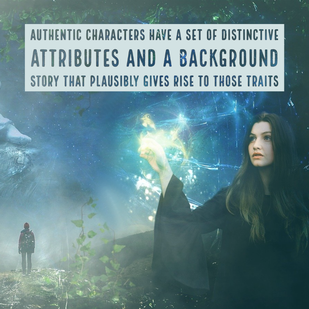 Hobbits Hide and Dragons Hoard
Hobbits Hide and Dragons Hoard
 Read this exchange from J. R. R. Tolkien’s The Hobbit, between the hobbit Bilbo Baggins and the dragon Smaug:
Read this exchange from J. R. R. Tolkien’s The Hobbit, between the hobbit Bilbo Baggins and the dragon Smaug:
"Well, thief! I smell you, and I feel your air. I hear you breathe. Come along! Help yourself again, there is plenty and to spare!"
But Bilbo was not quite so unlearned in dragon-lore as all that, and if Smaug hoped to get him to come nearer so easily, he was disappointed. "No thank you, O Smaug the Tremendous!" he replied.
"I did not come for presents. I only wished to have a look at you and see if you were truly as great as tales say. I did not believe them."
"Do you now?" said the dragon somewhat flattered, even though he did not believe a word of it.
"Truly songs and tales fall utterly short of the reality, O Smaug the Chiefest and Greatest of Calamities," replied Bilbo.
"You have nice manners for a thief and a liar," said the dragon.
Bilbo is tiny and rogue. Lying isn’t beneath him, and hiding is a necessity. Here, the dragon’s natural strengths, his enormous size, and his gold hoard are detrimental because Bilbo is, by nature, adept at hiding.
While both characters are tricky, neither of them fools the other. This is important. Bilbo tricking the dragon might help the plot, but you don’t get to be an ancient, wealthy dragon if you’re fooled by the first bit of flattery hurled your way. Bilbo wouldn’t go charging at the dragon to slay him. He’s a hobbit; hobbits hide.
To ensure characters’ authenticity, they must have a set of distinctive attributes and a background story that plausibly gives rise to those traits. They should adapt and change throughout the story in an arc that makes sense to their history and personality. The Bilbo Baggins at the end of The Hobbit differs from the one at the end of the book, but he still has most of the same fundamental characteristics. Authenticity in Action
To check for authenticity, take a few minutes and write something that your character would never do. Maybe they’d never eat meat, perhaps they’d never have children, perhaps they wouldn’t steal under any circumstances or go to bed without saying their prayers. Next, start building their backstory by writing why they’d never do it.
Other Blogs in this Series: Character Sketch A quick note: This will be my last blog for a month, apart from my Tripping the Multiverse cover release on November 17th. I’m taking part in NaNoWriMo for November. I’m only completing half the challenge. I can’t commit to a full novel because *gestures to everything,* but I plan on completing the second half of the next book in my Jade and Antigone series. Exciting times!
 Crafting Credibility Characters in sci-fi and fantasy often have paragon attributes and powers far above the average person walking around on the street. Even an ordinary citizen in a sci-fi likely has sensational gadgets that we don’t currently have access to.
Crafting Credibility Characters in sci-fi and fantasy often have paragon attributes and powers far above the average person walking around on the street. Even an ordinary citizen in a sci-fi likely has sensational gadgets that we don’t currently have access to.So, how do we make an elf, wizard, or bionic woman seem more realistic? The best way to ensure the authenticity of any kind of figure is to craft your character, give them a set of distinguishable traits, and, and this is the most crucial part, stick to those traits.
In successful science fiction or fantasy stories, the audience suspends their disbelief. For me, I’m willing to allow a writer to take me on implausible journeys to distance futures and surreal worlds. I want to believe in an alien or wizard. When a wizard or alien acts out of character or does something only to blatantly further the plot, my disbelief returns, and I’m no longer wrapped up in the story. I may even stop reading it.
 Hobbits Hide and Dragons Hoard
Hobbits Hide and Dragons Hoard Read this exchange from J. R. R. Tolkien’s The Hobbit, between the hobbit Bilbo Baggins and the dragon Smaug:
Read this exchange from J. R. R. Tolkien’s The Hobbit, between the hobbit Bilbo Baggins and the dragon Smaug:"Well, thief! I smell you, and I feel your air. I hear you breathe. Come along! Help yourself again, there is plenty and to spare!"
But Bilbo was not quite so unlearned in dragon-lore as all that, and if Smaug hoped to get him to come nearer so easily, he was disappointed. "No thank you, O Smaug the Tremendous!" he replied.
"I did not come for presents. I only wished to have a look at you and see if you were truly as great as tales say. I did not believe them."
"Do you now?" said the dragon somewhat flattered, even though he did not believe a word of it.
"Truly songs and tales fall utterly short of the reality, O Smaug the Chiefest and Greatest of Calamities," replied Bilbo.
"You have nice manners for a thief and a liar," said the dragon.
Bilbo is tiny and rogue. Lying isn’t beneath him, and hiding is a necessity. Here, the dragon’s natural strengths, his enormous size, and his gold hoard are detrimental because Bilbo is, by nature, adept at hiding.
While both characters are tricky, neither of them fools the other. This is important. Bilbo tricking the dragon might help the plot, but you don’t get to be an ancient, wealthy dragon if you’re fooled by the first bit of flattery hurled your way. Bilbo wouldn’t go charging at the dragon to slay him. He’s a hobbit; hobbits hide.
To ensure characters’ authenticity, they must have a set of distinctive attributes and a background story that plausibly gives rise to those traits. They should adapt and change throughout the story in an arc that makes sense to their history and personality. The Bilbo Baggins at the end of The Hobbit differs from the one at the end of the book, but he still has most of the same fundamental characteristics. Authenticity in Action
To check for authenticity, take a few minutes and write something that your character would never do. Maybe they’d never eat meat, perhaps they’d never have children, perhaps they wouldn’t steal under any circumstances or go to bed without saying their prayers. Next, start building their backstory by writing why they’d never do it.
Other Blogs in this Series: Character Sketch A quick note: This will be my last blog for a month, apart from my Tripping the Multiverse cover release on November 17th. I’m taking part in NaNoWriMo for November. I’m only completing half the challenge. I can’t commit to a full novel because *gestures to everything,* but I plan on completing the second half of the next book in my Jade and Antigone series. Exciting times!
Published on October 30, 2020 11:51
October 16, 2020
Real Characters in Unreal Worlds: Character Sketch
A story can have a vibrant world and a brilliant plot, but it’s all for naught if the characters don’t act like genuine people (or elves, trolls, whatever, you get it). This blog series is about creating authentic characters who act and react realistically in fantastic and futuristic worlds.
 Writing a rough character sketch is the first step to creating a fully formed fantasy or science fiction character ready to adventure in your world. Character sketches should focus mostly on the character’s traits and personality instead of looks. It’s much easier to craft your character’s outside once you’ve figured out their insides. Plus, their physicality might change throughout your personality crafting. Maybe their backstory gives them a scar, or they belong to an order wherein everyone has purple hair.
Writing a rough character sketch is the first step to creating a fully formed fantasy or science fiction character ready to adventure in your world. Character sketches should focus mostly on the character’s traits and personality instead of looks. It’s much easier to craft your character’s outside once you’ve figured out their insides. Plus, their physicality might change throughout your personality crafting. Maybe their backstory gives them a scar, or they belong to an order wherein everyone has purple hair.
Even though looks come later, you might not want to start from a blank slate, so your character basics might include a rough age, gender, and body type. I also like to add their name, their goals, and some stand out personality traits. Stand out qualities might include friendliness, level of conscientiousness, and emotional stability (or lack of these).
Sometimes, I start out with none of these, or just a name, and let the character reveal herself to me as I work through their backstory. But starting with a rough sketch often best. Here’s a checklist to help create character sketches NameAgeGenderPhysical AttributesAlignment (see my massive series on this topic)Obvious Personality Traits: things you would notice within five minutes of meeting this personGoals (either life of short term/adventure) That’s really it for the sketch list. Keep in mind a character sketch doesn’t have to meet all these criteria and often includes other info, such as the narrative reason you’re creating the character.
Next blog, I’m going to discuss a few quick tricks to make even minor characters authentic.
 Writing a rough character sketch is the first step to creating a fully formed fantasy or science fiction character ready to adventure in your world. Character sketches should focus mostly on the character’s traits and personality instead of looks. It’s much easier to craft your character’s outside once you’ve figured out their insides. Plus, their physicality might change throughout your personality crafting. Maybe their backstory gives them a scar, or they belong to an order wherein everyone has purple hair.
Writing a rough character sketch is the first step to creating a fully formed fantasy or science fiction character ready to adventure in your world. Character sketches should focus mostly on the character’s traits and personality instead of looks. It’s much easier to craft your character’s outside once you’ve figured out their insides. Plus, their physicality might change throughout your personality crafting. Maybe their backstory gives them a scar, or they belong to an order wherein everyone has purple hair.
Even though looks come later, you might not want to start from a blank slate, so your character basics might include a rough age, gender, and body type. I also like to add their name, their goals, and some stand out personality traits. Stand out qualities might include friendliness, level of conscientiousness, and emotional stability (or lack of these).
Sometimes, I start out with none of these, or just a name, and let the character reveal herself to me as I work through their backstory. But starting with a rough sketch often best. Here’s a checklist to help create character sketches NameAgeGenderPhysical AttributesAlignment (see my massive series on this topic)Obvious Personality Traits: things you would notice within five minutes of meeting this personGoals (either life of short term/adventure) That’s really it for the sketch list. Keep in mind a character sketch doesn’t have to meet all these criteria and often includes other info, such as the narrative reason you’re creating the character.
Next blog, I’m going to discuss a few quick tricks to make even minor characters authentic.
Published on October 16, 2020 09:19
October 2, 2020
Tripping the Multiverse Places: The Orion Center
My newest novel, Tripping the Multiverse, is also the first book in my Jade and Antigone series. I discussed the main characters in a blog a while back. I have some exciting dates coming up, including a Cover Release party on November 17, and the book comes out on January 21, 2021.
I thought I might write a few blogs exploring the places in Tripping the Multiverse, with the ubiquitous Orion Center as the first stop on the tour. The Orion Center’s Official Response to Press Inquiries: The Orion Center for Applied Quantum Physics The Orion Center for Applied Quantum Physics is the North East’s premier research facility specializing in making particle theory particle reality. This facility boasts one of the world’s only Large Hadron Colliders. The Orion Center’s Collider is the third most powerful particle accelerator ever built.
The Orion Center for Applied Quantum Physics The Orion Center for Applied Quantum Physics is the North East’s premier research facility specializing in making particle theory particle reality. This facility boasts one of the world’s only Large Hadron Colliders. The Orion Center’s Collider is the third most powerful particle accelerator ever built.
Recently, the researchers at the Orion Center have been able to isolate and stabilize two wormholes, which they are hoping to use for commercial transportation. To date, we have used the wormholes to transport multiple items across a laboratory, including a pencil, a book, and an uncooperative rabbit.
You may wonder if it’s safe to be near stabilized wormholes artificially generated by particle acceleration. The answer is a resounding yes. Probably. Orion researchers report no ill effects, aside from the occasional memory loss and spontaneous transportation to random locations within a mile radius of the Center. To date, the Orion Center has only lost one researcher to unexpected transportation that we know of. The stabilized wormholes occasionally erase missing researchers from the fabric of reality.
The Orion Center wormholes pose absolutely no danger to the population of Worbridge, however unexpected displacement of our entire dimension may occur. My discussion on the topic of wormhole safety will now cease.
If you have questions, stop by the Orion Center. It is open to the public on alternating Tuesdays between 1:30 and 12:30pm. The Orion Center welcomes you to an almost newly renovated reception area, located to the left of the security kiosk. Refrain from drinking the coffee, it may contain antimatter.
– Prepared by Director Harriet Carter Excited to see the cover of Tripping the Multiverse? Come to virtual Cover Reveal part on November 17th! Cover Party RSVP Tripping the Multiverse Characters
Cover Party RSVP Tripping the Multiverse Characters
I thought I might write a few blogs exploring the places in Tripping the Multiverse, with the ubiquitous Orion Center as the first stop on the tour. The Orion Center’s Official Response to Press Inquiries:
 The Orion Center for Applied Quantum Physics The Orion Center for Applied Quantum Physics is the North East’s premier research facility specializing in making particle theory particle reality. This facility boasts one of the world’s only Large Hadron Colliders. The Orion Center’s Collider is the third most powerful particle accelerator ever built.
The Orion Center for Applied Quantum Physics The Orion Center for Applied Quantum Physics is the North East’s premier research facility specializing in making particle theory particle reality. This facility boasts one of the world’s only Large Hadron Colliders. The Orion Center’s Collider is the third most powerful particle accelerator ever built.Recently, the researchers at the Orion Center have been able to isolate and stabilize two wormholes, which they are hoping to use for commercial transportation. To date, we have used the wormholes to transport multiple items across a laboratory, including a pencil, a book, and an uncooperative rabbit.
You may wonder if it’s safe to be near stabilized wormholes artificially generated by particle acceleration. The answer is a resounding yes. Probably. Orion researchers report no ill effects, aside from the occasional memory loss and spontaneous transportation to random locations within a mile radius of the Center. To date, the Orion Center has only lost one researcher to unexpected transportation that we know of. The stabilized wormholes occasionally erase missing researchers from the fabric of reality.
The Orion Center wormholes pose absolutely no danger to the population of Worbridge, however unexpected displacement of our entire dimension may occur. My discussion on the topic of wormhole safety will now cease.
If you have questions, stop by the Orion Center. It is open to the public on alternating Tuesdays between 1:30 and 12:30pm. The Orion Center welcomes you to an almost newly renovated reception area, located to the left of the security kiosk. Refrain from drinking the coffee, it may contain antimatter.
– Prepared by Director Harriet Carter Excited to see the cover of Tripping the Multiverse? Come to virtual Cover Reveal part on November 17th!
 Cover Party RSVP Tripping the Multiverse Characters
Cover Party RSVP Tripping the Multiverse Characters
Published on October 02, 2020 08:02
August 14, 2020
Writing Alignment: Neutral
I adapted this blog series from a section of an online workshop I conducted for Writers & Books in March 2020.
 The Situation Deciding a character’s alignment helps determine how they act during their adventures. I find it helpful to think about how each alignment would behave in the same circumstances because it highlights the differences between each alignment.
The Situation Deciding a character’s alignment helps determine how they act during their adventures. I find it helpful to think about how each alignment would behave in the same circumstances because it highlights the differences between each alignment.
Here’s the scene:
A character is in a market and encounters a thief who has stolen from them in a previous incident. The thief doesn’t see the character yet, so they have time to react. How will they act?
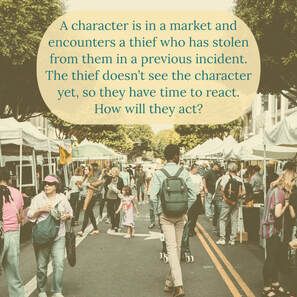 The neutral type would steal back precisely what the thief stole from her and continue on her way. She is not interested in payback, justice, or charity. She wants what the thief owes her, nothing more, and nothing less. That said, she will work hard to retrieve the stolen item and may not take responsibility for any mishaps caused by her pursuit.
The neutral type would steal back precisely what the thief stole from her and continue on her way. She is not interested in payback, justice, or charity. She wants what the thief owes her, nothing more, and nothing less. That said, she will work hard to retrieve the stolen item and may not take responsibility for any mishaps caused by her pursuit.
Defining Neutral Characters
However, she is singular, insular, and her allegiance never changes. What makes her neutral, despite having a cause, is the singularity of her chosen cause. She cares for literally nothing else. She practically sees nothing but herself and, perhaps, the subject of her devotion.
Neutral characters, also known as True Neutral, are not blank slates. They have an allegiance to something, and they are neutral to everything but that allegiance. A truly neutral character only has loyalty to themselves. But there can be neutral characters with allegiances to kingdoms, jobs, religions, or even a person.
 True neutral characters are few and far between. Subtypes of this character include all-knowing bystanders, hermits, self-absorbed cowards, and folks who just couldn’t be bothered.
True neutral characters are few and far between. Subtypes of this character include all-knowing bystanders, hermits, self-absorbed cowards, and folks who just couldn’t be bothered.
Neutral Character Development
True neutral characters are hard to write and, subsequently, are rare characters. Almost everyone has some motivation aside from preservation and a moral compass outside of observation. She is also a hard type to develop because her nature is static. She doesn’t care about you, and she never will.
On the other hand, she is adept at honing her skills in her area of interest, more so than different character types. If she’s interested in self-preservation via social climbing, she will eventually rise to the upper echelons of society. She has the potential to obsess her way into becoming a paragon. If she survives long enough, she could be the most peaceful monk, the world’s most powerful orator, the fastest swimmer, the highest-paid assassin, and so on. The important part is that her interest is all-encompassing.
I’ve seen writers hint at true neutral development with the “maybe she cares after all” plotlines usually involving a love interest or family ties. This situation reveals that the character is not truly neutral unless her attention is a minor diversion or ends up as part of a self-serving plot.
Neutral Character Examples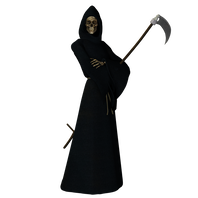 Death in the Discworld series is just there to do his job. It doesn’t matter to DEATH if you’re rich or poor, good or evil, souls need reaping, and he’s the one who will do it.
Death in the Discworld series is just there to do his job. It doesn’t matter to DEATH if you’re rich or poor, good or evil, souls need reaping, and he’s the one who will do it.
Watchmen’s Doctor Manhattan is the “impartial observer” subtype of true neutral. His omniscient nature removed his humanity, and he can’t bring himself to do anything but watch from afar.
Dr. Smith, from Lost in Space, both the current and previous incarnations of the character, is the classic true neutral character. Dr. Smith will do anything to survive, including manipulation, identity theft, and murder. The modern Dr. Smith is an excellent example of a neutral character who occasionally seems to take an interest in other people. Still, her concern for others always ends up a matter of self-interest. This is the last post in my Alignment Series!
Make sure to check out my other blog series!
Other Blogs in this Series: Intro to Alignment Lawful GoodChaotic GoodChaotic Neutral Chaotic EvilNeutral GoodNeutral Evil Lawful NeutralLawful Evil
 The Situation Deciding a character’s alignment helps determine how they act during their adventures. I find it helpful to think about how each alignment would behave in the same circumstances because it highlights the differences between each alignment.
The Situation Deciding a character’s alignment helps determine how they act during their adventures. I find it helpful to think about how each alignment would behave in the same circumstances because it highlights the differences between each alignment.
Here’s the scene:
A character is in a market and encounters a thief who has stolen from them in a previous incident. The thief doesn’t see the character yet, so they have time to react. How will they act?
 The neutral type would steal back precisely what the thief stole from her and continue on her way. She is not interested in payback, justice, or charity. She wants what the thief owes her, nothing more, and nothing less. That said, she will work hard to retrieve the stolen item and may not take responsibility for any mishaps caused by her pursuit.
The neutral type would steal back precisely what the thief stole from her and continue on her way. She is not interested in payback, justice, or charity. She wants what the thief owes her, nothing more, and nothing less. That said, she will work hard to retrieve the stolen item and may not take responsibility for any mishaps caused by her pursuit.Defining Neutral Characters
However, she is singular, insular, and her allegiance never changes. What makes her neutral, despite having a cause, is the singularity of her chosen cause. She cares for literally nothing else. She practically sees nothing but herself and, perhaps, the subject of her devotion.
Neutral characters, also known as True Neutral, are not blank slates. They have an allegiance to something, and they are neutral to everything but that allegiance. A truly neutral character only has loyalty to themselves. But there can be neutral characters with allegiances to kingdoms, jobs, religions, or even a person.
 True neutral characters are few and far between. Subtypes of this character include all-knowing bystanders, hermits, self-absorbed cowards, and folks who just couldn’t be bothered.
True neutral characters are few and far between. Subtypes of this character include all-knowing bystanders, hermits, self-absorbed cowards, and folks who just couldn’t be bothered.Neutral Character Development
True neutral characters are hard to write and, subsequently, are rare characters. Almost everyone has some motivation aside from preservation and a moral compass outside of observation. She is also a hard type to develop because her nature is static. She doesn’t care about you, and she never will.
On the other hand, she is adept at honing her skills in her area of interest, more so than different character types. If she’s interested in self-preservation via social climbing, she will eventually rise to the upper echelons of society. She has the potential to obsess her way into becoming a paragon. If she survives long enough, she could be the most peaceful monk, the world’s most powerful orator, the fastest swimmer, the highest-paid assassin, and so on. The important part is that her interest is all-encompassing.
I’ve seen writers hint at true neutral development with the “maybe she cares after all” plotlines usually involving a love interest or family ties. This situation reveals that the character is not truly neutral unless her attention is a minor diversion or ends up as part of a self-serving plot.
Neutral Character Examples
 Death in the Discworld series is just there to do his job. It doesn’t matter to DEATH if you’re rich or poor, good or evil, souls need reaping, and he’s the one who will do it.
Death in the Discworld series is just there to do his job. It doesn’t matter to DEATH if you’re rich or poor, good or evil, souls need reaping, and he’s the one who will do it.Watchmen’s Doctor Manhattan is the “impartial observer” subtype of true neutral. His omniscient nature removed his humanity, and he can’t bring himself to do anything but watch from afar.
Dr. Smith, from Lost in Space, both the current and previous incarnations of the character, is the classic true neutral character. Dr. Smith will do anything to survive, including manipulation, identity theft, and murder. The modern Dr. Smith is an excellent example of a neutral character who occasionally seems to take an interest in other people. Still, her concern for others always ends up a matter of self-interest. This is the last post in my Alignment Series!
Make sure to check out my other blog series!
Other Blogs in this Series: Intro to Alignment Lawful GoodChaotic GoodChaotic Neutral Chaotic EvilNeutral GoodNeutral Evil Lawful NeutralLawful Evil
Published on August 14, 2020 14:08
August 6, 2020
Am I Cursed?
I wrote this post as a part of my upcoming Fantasy and Science Fiction Reader’s Lounge Takeover.  Can someone curse you without your knowledge? Literary convention argues that you cannot. In Terry Pratchett’s Equal Rights, master witch Granny Weatherwax subscribes to “Headology.” According to her, if you give the evil eye to someone, they’ll blame their next bit of bad luck on your curse. Soon enough, you’re the reason for their misery, and it didn’t take a trace of magic.
Can someone curse you without your knowledge? Literary convention argues that you cannot. In Terry Pratchett’s Equal Rights, master witch Granny Weatherwax subscribes to “Headology.” According to her, if you give the evil eye to someone, they’ll blame their next bit of bad luck on your curse. Soon enough, you’re the reason for their misery, and it didn’t take a trace of magic.
Curses are made of three components: the curse giver, the person being cursed, and the belief in such a thing as curses. In this way, being hexed is a kind of hypnosis where a person subconsciously acts out the suggestion of the curse giver. Is this how it works in life? Maybe. You might walk under a ladder and then spill your coffee. Common sense dictates the two events are unconnected. If you believe dropping your coffee results from walking under a ladder, you’re committing a logical fallacy called post hoc ergo propter hoc. Or maybe the ladder cursed you. Who am I to say?
Is this how it works in life? Maybe. You might walk under a ladder and then spill your coffee. Common sense dictates the two events are unconnected. If you believe dropping your coffee results from walking under a ladder, you’re committing a logical fallacy called post hoc ergo propter hoc. Or maybe the ladder cursed you. Who am I to say?
Some magical curses in literature are not a result of Headology, though. Highly magical curses like that of the beast in Beauty and the Beast or the Unforgivable Curses in Harry Potter are so forceful they don’t require a shared belief in jinxes. In fact, fairytales are full of hexes with complex unraveling involving true love and kisses.
No, you cannot be unaware of a curse. Either your belief that someone cursed you is perpetuating your hardship, or the affliction is of a highly magical, unmistakable nature. So, go home, open your umbrella, snuggle your black cat, and ignore all those chain letters.
Come back next week for the final post in my Writing Alignment Series .
Remember to stop by the Fantasy and Sci-Fi Reader's Lounge on Friday, 8/7 from 2-4 for a live event with giveaways and cursing!
(kidding, not about the giveaway, though)
 Can someone curse you without your knowledge? Literary convention argues that you cannot. In Terry Pratchett’s Equal Rights, master witch Granny Weatherwax subscribes to “Headology.” According to her, if you give the evil eye to someone, they’ll blame their next bit of bad luck on your curse. Soon enough, you’re the reason for their misery, and it didn’t take a trace of magic.
Can someone curse you without your knowledge? Literary convention argues that you cannot. In Terry Pratchett’s Equal Rights, master witch Granny Weatherwax subscribes to “Headology.” According to her, if you give the evil eye to someone, they’ll blame their next bit of bad luck on your curse. Soon enough, you’re the reason for their misery, and it didn’t take a trace of magic.
Curses are made of three components: the curse giver, the person being cursed, and the belief in such a thing as curses. In this way, being hexed is a kind of hypnosis where a person subconsciously acts out the suggestion of the curse giver.
 Is this how it works in life? Maybe. You might walk under a ladder and then spill your coffee. Common sense dictates the two events are unconnected. If you believe dropping your coffee results from walking under a ladder, you’re committing a logical fallacy called post hoc ergo propter hoc. Or maybe the ladder cursed you. Who am I to say?
Is this how it works in life? Maybe. You might walk under a ladder and then spill your coffee. Common sense dictates the two events are unconnected. If you believe dropping your coffee results from walking under a ladder, you’re committing a logical fallacy called post hoc ergo propter hoc. Or maybe the ladder cursed you. Who am I to say?Some magical curses in literature are not a result of Headology, though. Highly magical curses like that of the beast in Beauty and the Beast or the Unforgivable Curses in Harry Potter are so forceful they don’t require a shared belief in jinxes. In fact, fairytales are full of hexes with complex unraveling involving true love and kisses.
No, you cannot be unaware of a curse. Either your belief that someone cursed you is perpetuating your hardship, or the affliction is of a highly magical, unmistakable nature. So, go home, open your umbrella, snuggle your black cat, and ignore all those chain letters.
Come back next week for the final post in my Writing Alignment Series .
Remember to stop by the Fantasy and Sci-Fi Reader's Lounge on Friday, 8/7 from 2-4 for a live event with giveaways and cursing!
(kidding, not about the giveaway, though)
Published on August 06, 2020 13:57
August 1, 2020
Writing Alignment: Lawful Evil
I adapted this blog series from a section of an online workshop I conducted for Writers & Books in March 2020.  The Situation Deciding a character’s alignment helps determine how’d they’d act during their adventures. I find it helpful to think about how each alignment would behave in the same circumstances because it highlights the differences between each alignment.
The Situation Deciding a character’s alignment helps determine how’d they’d act during their adventures. I find it helpful to think about how each alignment would behave in the same circumstances because it highlights the differences between each alignment.
Here’s the scene:
A character is in a market and encounters a thief who has stolen from them in a previous incident. The thief doesn’t see the character yet, so they have time to react. How will they act?
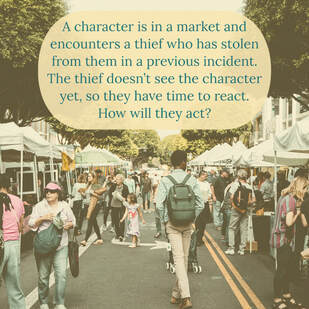 A lawful evil character would call his connections throughout the city to ensure they bring the thief to justice with the most severe punishment possible. If the character is in a foreign place away from the root of his influence, he will still call upon the law hoping law enforcement will jail her. He will always try a variety of means to sway the system in his favor.
A lawful evil character would call his connections throughout the city to ensure they bring the thief to justice with the most severe punishment possible. If the character is in a foreign place away from the root of his influence, he will still call upon the law hoping law enforcement will jail her. He will always try a variety of means to sway the system in his favor.
Defining Lawful Evil Characters
Lawful evil characters are often well-connected or wealthy individuals who exploit the system and use legal technicalities to their benefit. Lawful evil character subtypes include corrupt executives, dirty cops, and diabolical masterminds. He is quick, cruel, and hard to beat because the administration is on his side, or he is the administration, sometimes. Because of their insidious nature, many of the most heinous villains are lawful evil. It’s important to note, he doesn’t always follow the law, unlike the other lawful types. He’s happy to toe the line or appear legitimate while doing just enough to avoid legal consequences. More powerful lawful evil characters can write the rules, bending the law in their favor. The law is his weapon and shield.
It’s important to note, he doesn’t always follow the law, unlike the other lawful types. He’s happy to toe the line or appear legitimate while doing just enough to avoid legal consequences. More powerful lawful evil characters can write the rules, bending the law in their favor. The law is his weapon and shield.
Lawful Evil Character Development
The government or organization must have complicit members for the lawful evil character to exploit and cajole, and these toadies will eventually work their way up, providing a clear path for development. However, there are other routes to prominence.
A young lawful evil character might be a lackey for a more powerful character, waiting in the wings to take over when his leader fails or dies. Lawful evil characters are often wealthy, enjoying generations of esteem and political influence or a sudden influx of money and the power that comes with it.
Lawful Evil Character Examples
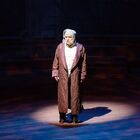 Dolores Umbridge from The Harry Potter franchise insists that everyone follows the rules, which she enforces in cruel ways. A corrupt system installed her in a position of power, and she gained prominence by aligning with influential villains.
Dolores Umbridge from The Harry Potter franchise insists that everyone follows the rules, which she enforces in cruel ways. A corrupt system installed her in a position of power, and she gained prominence by aligning with influential villains.
The Stephen King master of evil Randall Flagg, also known as “The Walking Man” from The Stand, is the malevolent lord subtype of lawful evil. He’s the guy in charge, he makes the rules, and everyone must follow them or face horrific consequences.
Ebenezer Scrooge from A Christmas Carol is lawful evil before his transformation. He does nothing to break the law, technically, but according to Charles Dickens, he’s a “squeezing, wrenching, grasping, scraping, clutching, covetous old sinner!” "There's more of gravy than of grave about you, whatever you are!”
Next week, I'm taking a break from alignment to talk about curses, which is the theme of my FSFRL Takeover next Friday.
Then, I'll be back with my final installment, True Neutral, the hardest alignment to get right!
Other Blogs in this Series: Intro to Alignment Lawful GoodChaotic GoodChaotic Neutral Chaotic EvilNeutral GoodNeutral Evil Lawful Neutral
 The Situation Deciding a character’s alignment helps determine how’d they’d act during their adventures. I find it helpful to think about how each alignment would behave in the same circumstances because it highlights the differences between each alignment.
The Situation Deciding a character’s alignment helps determine how’d they’d act during their adventures. I find it helpful to think about how each alignment would behave in the same circumstances because it highlights the differences between each alignment.
Here’s the scene:
A character is in a market and encounters a thief who has stolen from them in a previous incident. The thief doesn’t see the character yet, so they have time to react. How will they act?
 A lawful evil character would call his connections throughout the city to ensure they bring the thief to justice with the most severe punishment possible. If the character is in a foreign place away from the root of his influence, he will still call upon the law hoping law enforcement will jail her. He will always try a variety of means to sway the system in his favor.
A lawful evil character would call his connections throughout the city to ensure they bring the thief to justice with the most severe punishment possible. If the character is in a foreign place away from the root of his influence, he will still call upon the law hoping law enforcement will jail her. He will always try a variety of means to sway the system in his favor.Defining Lawful Evil Characters
Lawful evil characters are often well-connected or wealthy individuals who exploit the system and use legal technicalities to their benefit. Lawful evil character subtypes include corrupt executives, dirty cops, and diabolical masterminds. He is quick, cruel, and hard to beat because the administration is on his side, or he is the administration, sometimes. Because of their insidious nature, many of the most heinous villains are lawful evil.
 It’s important to note, he doesn’t always follow the law, unlike the other lawful types. He’s happy to toe the line or appear legitimate while doing just enough to avoid legal consequences. More powerful lawful evil characters can write the rules, bending the law in their favor. The law is his weapon and shield.
It’s important to note, he doesn’t always follow the law, unlike the other lawful types. He’s happy to toe the line or appear legitimate while doing just enough to avoid legal consequences. More powerful lawful evil characters can write the rules, bending the law in their favor. The law is his weapon and shield.Lawful Evil Character Development
The government or organization must have complicit members for the lawful evil character to exploit and cajole, and these toadies will eventually work their way up, providing a clear path for development. However, there are other routes to prominence.
A young lawful evil character might be a lackey for a more powerful character, waiting in the wings to take over when his leader fails or dies. Lawful evil characters are often wealthy, enjoying generations of esteem and political influence or a sudden influx of money and the power that comes with it.
Lawful Evil Character Examples
 Dolores Umbridge from The Harry Potter franchise insists that everyone follows the rules, which she enforces in cruel ways. A corrupt system installed her in a position of power, and she gained prominence by aligning with influential villains.
Dolores Umbridge from The Harry Potter franchise insists that everyone follows the rules, which she enforces in cruel ways. A corrupt system installed her in a position of power, and she gained prominence by aligning with influential villains.The Stephen King master of evil Randall Flagg, also known as “The Walking Man” from The Stand, is the malevolent lord subtype of lawful evil. He’s the guy in charge, he makes the rules, and everyone must follow them or face horrific consequences.
Ebenezer Scrooge from A Christmas Carol is lawful evil before his transformation. He does nothing to break the law, technically, but according to Charles Dickens, he’s a “squeezing, wrenching, grasping, scraping, clutching, covetous old sinner!” "There's more of gravy than of grave about you, whatever you are!”
Next week, I'm taking a break from alignment to talk about curses, which is the theme of my FSFRL Takeover next Friday.
Then, I'll be back with my final installment, True Neutral, the hardest alignment to get right!
Other Blogs in this Series: Intro to Alignment Lawful GoodChaotic GoodChaotic Neutral Chaotic EvilNeutral GoodNeutral Evil Lawful Neutral
Published on August 01, 2020 07:15
July 17, 2020
Writing Alignment: Lawful Neutral
I adapt this blog series from a section of an online workshop I conducted for Writers & Books in March 2020.
 The Situation Deciding a character’s alignment helps determine how’d they’d act during their adventures. I find it helpful to think about how each alignment would behave in the same circumstances because it highlights the differences between each alignment.
The Situation Deciding a character’s alignment helps determine how’d they’d act during their adventures. I find it helpful to think about how each alignment would behave in the same circumstances because it highlights the differences between each alignment.
Here’s the scene:
A character is in a market and encounters a thief who has stolen from them in a previous incident. The thief doesn’t see the character yet, so they have time to react. How will they act?
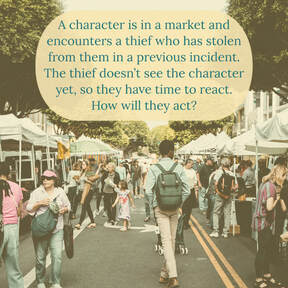 A lawful neutral character would place the thief under citizen’s arrest and bring them to the courthouse. She does not interpret the ideology she follows through either a negative or a positive filter. She doesn’t care that the thief stole from her, just that he stole, which violates the rules. You cannot appeal to the better (or worse) nature of these characters. She shows no mercy because the law will give mercy if it’s warranted. Defining Lawful Neutral Characters Like all the neutral pairings, the lawful neutral character acts as an embodiment of the trait accompanying their neutrality. However, “lawful” is a bit of a misnomer because these characters are loyal to the rules of their chosen society or association, which may not connect to the law of the land. A lawful neutral character is unlikely to break the law unless they are so devoted or cloistered, they are unaware of the law.
A lawful neutral character would place the thief under citizen’s arrest and bring them to the courthouse. She does not interpret the ideology she follows through either a negative or a positive filter. She doesn’t care that the thief stole from her, just that he stole, which violates the rules. You cannot appeal to the better (or worse) nature of these characters. She shows no mercy because the law will give mercy if it’s warranted. Defining Lawful Neutral Characters Like all the neutral pairings, the lawful neutral character acts as an embodiment of the trait accompanying their neutrality. However, “lawful” is a bit of a misnomer because these characters are loyal to the rules of their chosen society or association, which may not connect to the law of the land. A lawful neutral character is unlikely to break the law unless they are so devoted or cloistered, they are unaware of the law.
 The military lawful neutral character is a loyal soldier who mindlessly follows the rules with no regard for if they are fair, right or wrong. There are no shades of gray with these folks. In evil empires, they are ideal soldiers because they unquestionably follow orders. In good or neutral countries, they are the unremarkable agents of the government.
The military lawful neutral character is a loyal soldier who mindlessly follows the rules with no regard for if they are fair, right or wrong. There are no shades of gray with these folks. In evil empires, they are ideal soldiers because they unquestionably follow orders. In good or neutral countries, they are the unremarkable agents of the government.
Bureaucrats also follow the letter of the law, be it the actual law of the land, or, more often, the law of their companies and organizations. The bureaucratic lawful neutral sub-type prides herself on her paperwork navigation skills.
Last, we have the sticklers. She is the sort who raises her hand at the end of class to remind the teacher he forgot to assign homework. Similar to the bureaucrat, no one likes a stickler, but they’re a necessary cog in the gears of civilization.
Lawful Neutral Character Development Lawful neutral character development happens through skill-building and intellectual management. She may become a better warrior, a smarter statistician, or a harsher disciplinarian. A bureaucrat will become more bureaucratic. However, a lawful neutral character will never develop morally. This is because she ties her belief system to her society. She can be deceptive, however, acting as a covert agent for her institution, which may be the only reason she breaks a rule or law.
But (you’re probably asking) what if something is illegal but morally correct? There is no such thing to a lawful neutral character. When confronted with morality over legality, she will dismiss it until she no longer can, and then sputter around like a malfunctioning robot until she reasons her way out of the moral conundrum.
If the society or organization she follows becomes more or less virtuous, she will follow suit. So, sometimes, her personal development is contingent on the evolution of the association whose rules and laws she adheres to.
Lawful Neutral Character Examples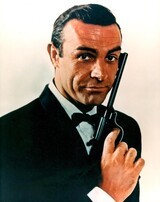 Police Inspector Javert in Les Misérables does not care that Jean Valjean only stole bread because he was starving. Javert believes all thieves are evil people who he should punish. When Valjean proves himself an honorable man, Javert cannot handle his own cognitive dissonance.
Police Inspector Javert in Les Misérables does not care that Jean Valjean only stole bread because he was starving. Javert believes all thieves are evil people who he should punish. When Valjean proves himself an honorable man, Javert cannot handle his own cognitive dissonance.
The Hogwarts caretaker in Harry Potter, Argus Filch, is a stickler, and no one likes him or his tattletale cat. He responds to even the smallest rule infraction with discipline and relishes his firm grip on regulation.
“Bond, James Bond” from the Bond franchise proves that some lawful neutral characters can be fun. He’s a secret agent following directives from the British Secret Service, but he maintains a distinct personality. Next week I'm Discussing Lawful Evil Characters! Other Blogs in this Series:Intro to Writing Alignment
Lawful GoodChaotic GoodChaotic Neutral Chaotic EvilNeutral GoodNeutral Evil
 The Situation Deciding a character’s alignment helps determine how’d they’d act during their adventures. I find it helpful to think about how each alignment would behave in the same circumstances because it highlights the differences between each alignment.
The Situation Deciding a character’s alignment helps determine how’d they’d act during their adventures. I find it helpful to think about how each alignment would behave in the same circumstances because it highlights the differences between each alignment.Here’s the scene:
A character is in a market and encounters a thief who has stolen from them in a previous incident. The thief doesn’t see the character yet, so they have time to react. How will they act?
 A lawful neutral character would place the thief under citizen’s arrest and bring them to the courthouse. She does not interpret the ideology she follows through either a negative or a positive filter. She doesn’t care that the thief stole from her, just that he stole, which violates the rules. You cannot appeal to the better (or worse) nature of these characters. She shows no mercy because the law will give mercy if it’s warranted. Defining Lawful Neutral Characters Like all the neutral pairings, the lawful neutral character acts as an embodiment of the trait accompanying their neutrality. However, “lawful” is a bit of a misnomer because these characters are loyal to the rules of their chosen society or association, which may not connect to the law of the land. A lawful neutral character is unlikely to break the law unless they are so devoted or cloistered, they are unaware of the law.
A lawful neutral character would place the thief under citizen’s arrest and bring them to the courthouse. She does not interpret the ideology she follows through either a negative or a positive filter. She doesn’t care that the thief stole from her, just that he stole, which violates the rules. You cannot appeal to the better (or worse) nature of these characters. She shows no mercy because the law will give mercy if it’s warranted. Defining Lawful Neutral Characters Like all the neutral pairings, the lawful neutral character acts as an embodiment of the trait accompanying their neutrality. However, “lawful” is a bit of a misnomer because these characters are loyal to the rules of their chosen society or association, which may not connect to the law of the land. A lawful neutral character is unlikely to break the law unless they are so devoted or cloistered, they are unaware of the law. The military lawful neutral character is a loyal soldier who mindlessly follows the rules with no regard for if they are fair, right or wrong. There are no shades of gray with these folks. In evil empires, they are ideal soldiers because they unquestionably follow orders. In good or neutral countries, they are the unremarkable agents of the government.
The military lawful neutral character is a loyal soldier who mindlessly follows the rules with no regard for if they are fair, right or wrong. There are no shades of gray with these folks. In evil empires, they are ideal soldiers because they unquestionably follow orders. In good or neutral countries, they are the unremarkable agents of the government.Bureaucrats also follow the letter of the law, be it the actual law of the land, or, more often, the law of their companies and organizations. The bureaucratic lawful neutral sub-type prides herself on her paperwork navigation skills.
Last, we have the sticklers. She is the sort who raises her hand at the end of class to remind the teacher he forgot to assign homework. Similar to the bureaucrat, no one likes a stickler, but they’re a necessary cog in the gears of civilization.
Lawful Neutral Character Development Lawful neutral character development happens through skill-building and intellectual management. She may become a better warrior, a smarter statistician, or a harsher disciplinarian. A bureaucrat will become more bureaucratic. However, a lawful neutral character will never develop morally. This is because she ties her belief system to her society. She can be deceptive, however, acting as a covert agent for her institution, which may be the only reason she breaks a rule or law.
But (you’re probably asking) what if something is illegal but morally correct? There is no such thing to a lawful neutral character. When confronted with morality over legality, she will dismiss it until she no longer can, and then sputter around like a malfunctioning robot until she reasons her way out of the moral conundrum.
If the society or organization she follows becomes more or less virtuous, she will follow suit. So, sometimes, her personal development is contingent on the evolution of the association whose rules and laws she adheres to.
Lawful Neutral Character Examples
 Police Inspector Javert in Les Misérables does not care that Jean Valjean only stole bread because he was starving. Javert believes all thieves are evil people who he should punish. When Valjean proves himself an honorable man, Javert cannot handle his own cognitive dissonance.
Police Inspector Javert in Les Misérables does not care that Jean Valjean only stole bread because he was starving. Javert believes all thieves are evil people who he should punish. When Valjean proves himself an honorable man, Javert cannot handle his own cognitive dissonance.The Hogwarts caretaker in Harry Potter, Argus Filch, is a stickler, and no one likes him or his tattletale cat. He responds to even the smallest rule infraction with discipline and relishes his firm grip on regulation.
“Bond, James Bond” from the Bond franchise proves that some lawful neutral characters can be fun. He’s a secret agent following directives from the British Secret Service, but he maintains a distinct personality. Next week I'm Discussing Lawful Evil Characters! Other Blogs in this Series:Intro to Writing Alignment
Lawful GoodChaotic GoodChaotic Neutral Chaotic EvilNeutral GoodNeutral Evil
Published on July 17, 2020 10:40
July 10, 2020
Writing Alignment: Neutral Evil
I adapted this blog series from a section of an online workshop I conducted for Writers & Books in March 2020. 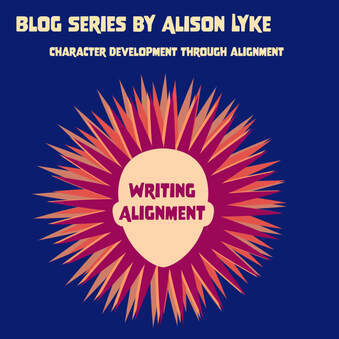 The Situation Deciding a character’s alignment helps determine how they act during their adventures. I find it helpful to think about how each alignment would behave in the same circumstances because it highlights the differences between each alignment.
The Situation Deciding a character’s alignment helps determine how they act during their adventures. I find it helpful to think about how each alignment would behave in the same circumstances because it highlights the differences between each alignment.
Here’s the scene:
A character is in a market and encounters a thief who has stolen from them in a previous incident. The thief doesn’t see the character yet, so they have time to react. How will they act?
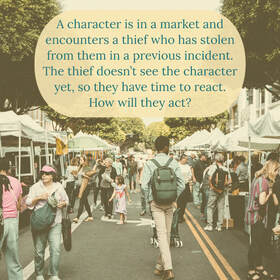 A neutral evil character would discreetly follow the thief until they were in a private area, kill him, and rob his corpse. Unlike some of our other alignments, the value of the stolen item doesn’t matter to her, it could be a trinket or a treasure chest. The neutral evil character demands retribution for even the smallest infraction. The only thing stopping her is self-preservation. If the thief is likely to overpower her, or if he is part of a ruling social class, she may save her wrath for another day. But she will never forget.
A neutral evil character would discreetly follow the thief until they were in a private area, kill him, and rob his corpse. Unlike some of our other alignments, the value of the stolen item doesn’t matter to her, it could be a trinket or a treasure chest. The neutral evil character demands retribution for even the smallest infraction. The only thing stopping her is self-preservation. If the thief is likely to overpower her, or if he is part of a ruling social class, she may save her wrath for another day. But she will never forget.
Defining Neutral Evil Characters Singularly concerned with themselves and their own agendas, neutral evil characters have no conscious and feel no guilt about ruthlessly pursuing objectives. The neutral evil character’s goals are usually selfish; if she’s working for an organization or is part of a family, she may appear to support them, but only if it suits her grand scheme.
 However evil, she tends to be quiet about her malevolence. Neutral evil characters are long-con plotters, who may hide their true nature. They are often sophisticated, but when they’re not, they are brute bullies relishing in any suffering that isn’t their own. She may also be a malignant narcissist, believing that she is better than everyone and that the world owes her, and needs to pay up now.
However evil, she tends to be quiet about her malevolence. Neutral evil characters are long-con plotters, who may hide their true nature. They are often sophisticated, but when they’re not, they are brute bullies relishing in any suffering that isn’t their own. She may also be a malignant narcissist, believing that she is better than everyone and that the world owes her, and needs to pay up now.
Neutral Evil Character Development These characters are often schemers, so one of the easiest ways to develop her would be to increase the complexity of her cons. Or she could start out at failing at her plots and then slowly get better at conspiracy. Often, her character development comes as a revelation to the other characters (or the readers) because she concealed her evil nature until her “good” persona outlived its usefulness.
Neutral Evil Character Examples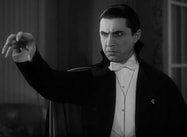 Heathcliff from Wuthering Heights cares only for himself and his love for Catherine. When he can’t marry her, he launches into a lifelong plot to destroy everyone who kept him from his love. His vengeance extends to the heirs of those who wronged him and lasts beyond the grave.
Heathcliff from Wuthering Heights cares only for himself and his love for Catherine. When he can’t marry her, he launches into a lifelong plot to destroy everyone who kept him from his love. His vengeance extends to the heirs of those who wronged him and lasts beyond the grave.
Senator Palpatine/ Darth Sidious /Emperor Palpatine from the Star Wars franchise is the long-con type of neutral evil character whose evil nature is a revelation to those who trusted him. While he plays the helpful Senator, he’s secretly the manipulative Darth Sidious, gaining legions of followers. When he no longer needs his Senator persona, he becomes the evil emperor.
Dracula, in his many incarnations, and vampires in general, are neutral evil. Vampires (not as a rule, but usually) are consumed by hunger for blood and the need to kill for it. Their constant need for murder makes vampires schemers out of self-preservation. The vampires who survive are the ones who can plan and cover their tracks.
"There is a great disturbance in the Force."
Next week I’m discussing lawful neutral characters. Other Blogs in this Series:Intro to Writing Alignment
Lawful GoodChaotic GoodChaotic Neutral Chaotic EvilNeutral Good
 The Situation Deciding a character’s alignment helps determine how they act during their adventures. I find it helpful to think about how each alignment would behave in the same circumstances because it highlights the differences between each alignment.
The Situation Deciding a character’s alignment helps determine how they act during their adventures. I find it helpful to think about how each alignment would behave in the same circumstances because it highlights the differences between each alignment.
Here’s the scene:
A character is in a market and encounters a thief who has stolen from them in a previous incident. The thief doesn’t see the character yet, so they have time to react. How will they act?
 A neutral evil character would discreetly follow the thief until they were in a private area, kill him, and rob his corpse. Unlike some of our other alignments, the value of the stolen item doesn’t matter to her, it could be a trinket or a treasure chest. The neutral evil character demands retribution for even the smallest infraction. The only thing stopping her is self-preservation. If the thief is likely to overpower her, or if he is part of a ruling social class, she may save her wrath for another day. But she will never forget.
A neutral evil character would discreetly follow the thief until they were in a private area, kill him, and rob his corpse. Unlike some of our other alignments, the value of the stolen item doesn’t matter to her, it could be a trinket or a treasure chest. The neutral evil character demands retribution for even the smallest infraction. The only thing stopping her is self-preservation. If the thief is likely to overpower her, or if he is part of a ruling social class, she may save her wrath for another day. But she will never forget. Defining Neutral Evil Characters Singularly concerned with themselves and their own agendas, neutral evil characters have no conscious and feel no guilt about ruthlessly pursuing objectives. The neutral evil character’s goals are usually selfish; if she’s working for an organization or is part of a family, she may appear to support them, but only if it suits her grand scheme.
 However evil, she tends to be quiet about her malevolence. Neutral evil characters are long-con plotters, who may hide their true nature. They are often sophisticated, but when they’re not, they are brute bullies relishing in any suffering that isn’t their own. She may also be a malignant narcissist, believing that she is better than everyone and that the world owes her, and needs to pay up now.
However evil, she tends to be quiet about her malevolence. Neutral evil characters are long-con plotters, who may hide their true nature. They are often sophisticated, but when they’re not, they are brute bullies relishing in any suffering that isn’t their own. She may also be a malignant narcissist, believing that she is better than everyone and that the world owes her, and needs to pay up now. Neutral Evil Character Development These characters are often schemers, so one of the easiest ways to develop her would be to increase the complexity of her cons. Or she could start out at failing at her plots and then slowly get better at conspiracy. Often, her character development comes as a revelation to the other characters (or the readers) because she concealed her evil nature until her “good” persona outlived its usefulness.
Neutral Evil Character Examples
 Heathcliff from Wuthering Heights cares only for himself and his love for Catherine. When he can’t marry her, he launches into a lifelong plot to destroy everyone who kept him from his love. His vengeance extends to the heirs of those who wronged him and lasts beyond the grave.
Heathcliff from Wuthering Heights cares only for himself and his love for Catherine. When he can’t marry her, he launches into a lifelong plot to destroy everyone who kept him from his love. His vengeance extends to the heirs of those who wronged him and lasts beyond the grave.Senator Palpatine/ Darth Sidious /Emperor Palpatine from the Star Wars franchise is the long-con type of neutral evil character whose evil nature is a revelation to those who trusted him. While he plays the helpful Senator, he’s secretly the manipulative Darth Sidious, gaining legions of followers. When he no longer needs his Senator persona, he becomes the evil emperor.
Dracula, in his many incarnations, and vampires in general, are neutral evil. Vampires (not as a rule, but usually) are consumed by hunger for blood and the need to kill for it. Their constant need for murder makes vampires schemers out of self-preservation. The vampires who survive are the ones who can plan and cover their tracks.
"There is a great disturbance in the Force."
Next week I’m discussing lawful neutral characters. Other Blogs in this Series:Intro to Writing Alignment
Lawful GoodChaotic GoodChaotic Neutral Chaotic EvilNeutral Good
Published on July 10, 2020 08:39
June 27, 2020
Writing Alignment: Neutral Good
I adapted this blog series from a section of an online workshop I conducted for Writers & Books in March 2020.
 The Situation
The Situation
Deciding a character’s alignment helps determine how they act during their adventures. I find it helpful to think about how each alignment would behave in the same circumstances because it highlights the differences between each alignment.
Here’s the scene:
A character is in a market and encounters a thief who has stolen from them in a previous incident. The thief doesn’t see the character yet, so they have time to react. How will they act?
 A neutral good character would offer to buy the thief lunch. The thief is obviously in need, why else would she have stolen? Compassion motivates the neutral good character. He will fix people (or living beings) first, problems second. If his dilemma involves a theft, he sees a thieving soul suffering as the issue, not a missing item.
A neutral good character would offer to buy the thief lunch. The thief is obviously in need, why else would she have stolen? Compassion motivates the neutral good character. He will fix people (or living beings) first, problems second. If his dilemma involves a theft, he sees a thieving soul suffering as the issue, not a missing item.
Defining Neutral Good Characters
Neutral good characters might not be religious, but they radiate the altruism you see in spiritual leaders and monks. His benevolence extends to all people, and creatures depending on the setting. This is the only positive alignment willing to protect all other alignments because a neutral good character’s charity transcends both the nature of those in need and the law of the land. Their indifference to the law means these characters often sympathize with rebels fighting subjugation.
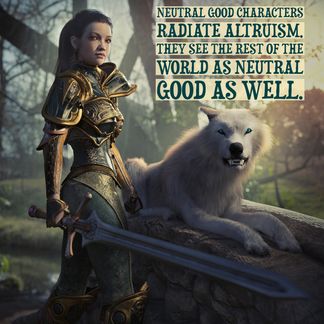 Also unique to the neutral good character is his extension of his alignment. He sees the rest of his world as neutral good as well. His reasoning for the evil deeds and poor behavior of others depends on his background and personal philosophy. He may see the cause of evil as a response to suffering, or think people inherently good, with a few missteps. Humble heroes, generous mentors, and classic princesses fall under this alignment.
Also unique to the neutral good character is his extension of his alignment. He sees the rest of his world as neutral good as well. His reasoning for the evil deeds and poor behavior of others depends on his background and personal philosophy. He may see the cause of evil as a response to suffering, or think people inherently good, with a few missteps. Humble heroes, generous mentors, and classic princesses fall under this alignment.
Neutral Good Character Development There is a myriad of ways you can develop this character. New on his journey, a neutral good character may be naïve and become world-wise within his story arc. On the other hand, an already world-weary neutral good character may help others, but neglect himself, resulting in issues in his personal relationships, that he must work to amend. Finally, a neutral good hero could expand his heroics, first aiding his friends, then his city, then the entire world.
Neutral Good Character Examples
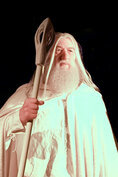 Gandalf from The Hobbit and The Lord of The Rings trilogy wishes everyone well as he uses his powers to fight evil. He cares about everyone, from the tiniest hobbit to the mightiest of kings. Gandalf’s good deeds are organized and strategic; he has learned how to maximize his heroics.
Gandalf from The Hobbit and The Lord of The Rings trilogy wishes everyone well as he uses his powers to fight evil. He cares about everyone, from the tiniest hobbit to the mightiest of kings. Gandalf’s good deeds are organized and strategic; he has learned how to maximize his heroics.
Sherlock Holmes seems to work to uphold the law, but he endeavors outside of it whenever necessary. Holmes helps those who need it, regardless of their history or social station. Really, he’s not an agent of the law, but an agent of human compassion.
Geralt from The Witcher is a compelling case because he wishes he were truly neutral, but he’s neutral good. He has an awareness of his alignment and the desire, but inability, to change it. Geralt is lax in personal care and relationship maintenance, which is a reoccurring theme with many neutral good characters.
You know my methods. Next week I'm writing about neutral evil characters. Other Blogs in This Series:Intro to AlignmentLawful GoodChaotic GoodChaotic Neutral Chaotic Evil
 The Situation
The SituationDeciding a character’s alignment helps determine how they act during their adventures. I find it helpful to think about how each alignment would behave in the same circumstances because it highlights the differences between each alignment.
Here’s the scene:
A character is in a market and encounters a thief who has stolen from them in a previous incident. The thief doesn’t see the character yet, so they have time to react. How will they act?
 A neutral good character would offer to buy the thief lunch. The thief is obviously in need, why else would she have stolen? Compassion motivates the neutral good character. He will fix people (or living beings) first, problems second. If his dilemma involves a theft, he sees a thieving soul suffering as the issue, not a missing item.
A neutral good character would offer to buy the thief lunch. The thief is obviously in need, why else would she have stolen? Compassion motivates the neutral good character. He will fix people (or living beings) first, problems second. If his dilemma involves a theft, he sees a thieving soul suffering as the issue, not a missing item. Defining Neutral Good Characters
Neutral good characters might not be religious, but they radiate the altruism you see in spiritual leaders and monks. His benevolence extends to all people, and creatures depending on the setting. This is the only positive alignment willing to protect all other alignments because a neutral good character’s charity transcends both the nature of those in need and the law of the land. Their indifference to the law means these characters often sympathize with rebels fighting subjugation.
 Also unique to the neutral good character is his extension of his alignment. He sees the rest of his world as neutral good as well. His reasoning for the evil deeds and poor behavior of others depends on his background and personal philosophy. He may see the cause of evil as a response to suffering, or think people inherently good, with a few missteps. Humble heroes, generous mentors, and classic princesses fall under this alignment.
Also unique to the neutral good character is his extension of his alignment. He sees the rest of his world as neutral good as well. His reasoning for the evil deeds and poor behavior of others depends on his background and personal philosophy. He may see the cause of evil as a response to suffering, or think people inherently good, with a few missteps. Humble heroes, generous mentors, and classic princesses fall under this alignment.Neutral Good Character Development There is a myriad of ways you can develop this character. New on his journey, a neutral good character may be naïve and become world-wise within his story arc. On the other hand, an already world-weary neutral good character may help others, but neglect himself, resulting in issues in his personal relationships, that he must work to amend. Finally, a neutral good hero could expand his heroics, first aiding his friends, then his city, then the entire world.
Neutral Good Character Examples
 Gandalf from The Hobbit and The Lord of The Rings trilogy wishes everyone well as he uses his powers to fight evil. He cares about everyone, from the tiniest hobbit to the mightiest of kings. Gandalf’s good deeds are organized and strategic; he has learned how to maximize his heroics.
Gandalf from The Hobbit and The Lord of The Rings trilogy wishes everyone well as he uses his powers to fight evil. He cares about everyone, from the tiniest hobbit to the mightiest of kings. Gandalf’s good deeds are organized and strategic; he has learned how to maximize his heroics.Sherlock Holmes seems to work to uphold the law, but he endeavors outside of it whenever necessary. Holmes helps those who need it, regardless of their history or social station. Really, he’s not an agent of the law, but an agent of human compassion.
Geralt from The Witcher is a compelling case because he wishes he were truly neutral, but he’s neutral good. He has an awareness of his alignment and the desire, but inability, to change it. Geralt is lax in personal care and relationship maintenance, which is a reoccurring theme with many neutral good characters.
You know my methods. Next week I'm writing about neutral evil characters. Other Blogs in This Series:Intro to AlignmentLawful GoodChaotic GoodChaotic Neutral Chaotic Evil
Published on June 27, 2020 07:49



